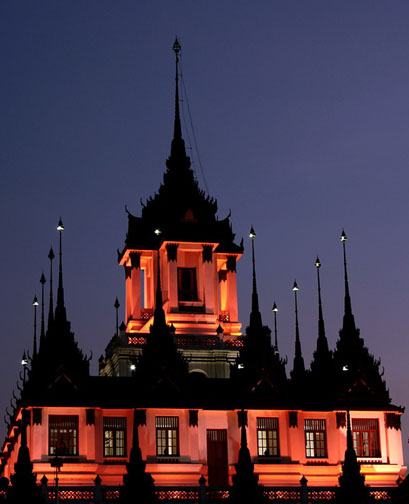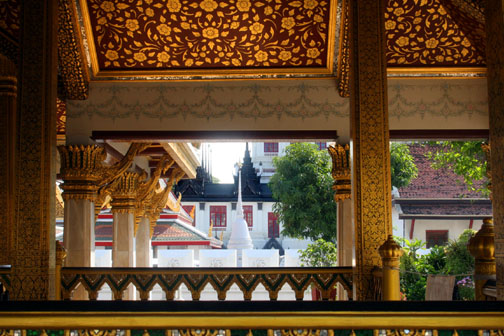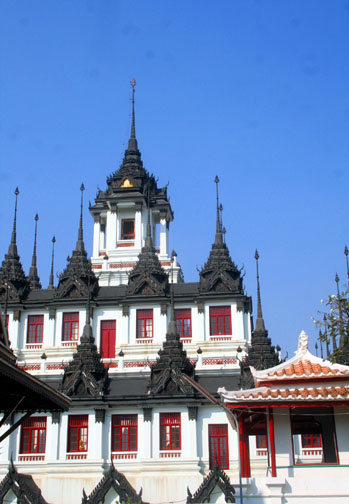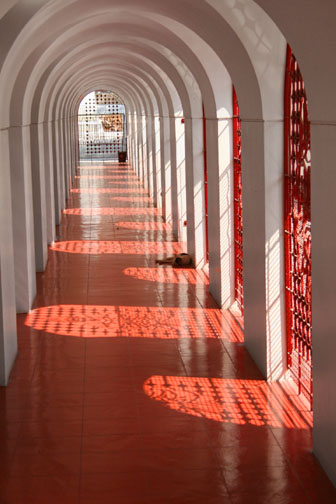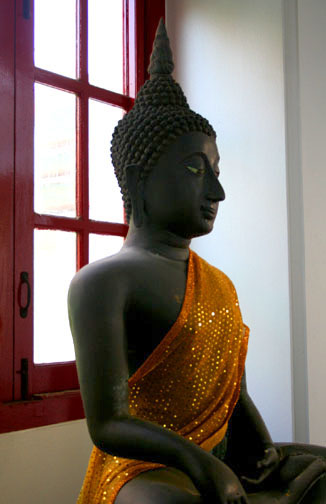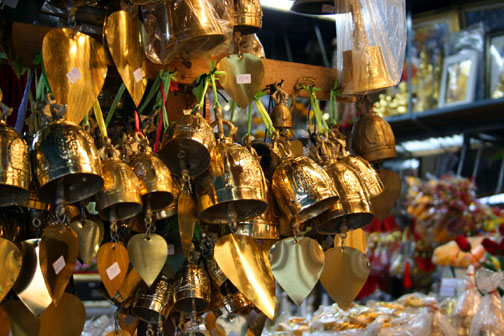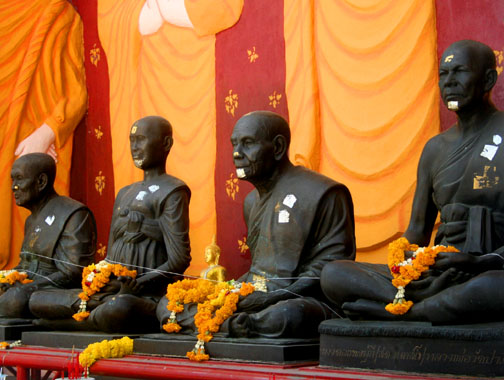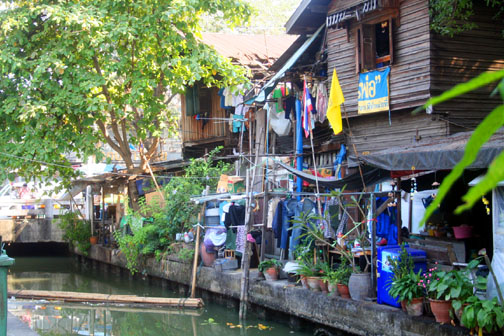I couldn’t tell you how many times I’d passed Wat Ratchanadda on my way to Khaosan Road, nor why I never made a point to stop there. The wat’s unique black spires set it apart from other wats in Bangkok; as fond of wats as I am, a visit should have been in order years ago. But since I make the trip past Wat Ratchanadda several times on each visit to Bangkok, its accessibility worked to its disadvantage; it always remained on my list of places to see in the Big Mango, but never made it to the top. On a recent trip at the height of rush hour when taxis willing to make the trek back to Silom were nonexistent, I decided to take the time and hike over to check the wat out.
Crossing from Khaosan to the side of the street the wat sits on, there is a wide, shady cobblestone boulevard to stroll down with plenty of benches along the way to stop and rest if you are not an avid walker. It’s not that far of a journey, but further than most are willing to make in Bangkok’s heat. A few graffiti strewn back lanes and an abundance of streetcart vendors selling food along the way was enough to peak my interest and convinced me the walk would be a better idea than negotiating an overpriced tuk tuk ride from the backpacker ghetto.
In front of the grounds of the wat, along Ratchadamnoen Road, there are several ornate pavilions surrounded by a formal plaza alive with bright red blossoms. To the far left, a statue of Rama III – construction of the wat began during his reign – anchors the corner. A great place to take a few photos, if you are in any doubt that you’re at a major touri spot the mass of tuk tuk drivers who will descend on you offering 50 baht tours of the surrounding wats in he Old City (along with several jewelry showrooms and tailor shops) should convince you that at least to the locals, Wat Ratchanadda is a place touri should see. But I’ve been there three times now, at different times of the day on each visit, and the grounds are never filled with foreign visitors. In fact you are more likely to run across Thais during your visit than you are other Westeners. That is a bit surprising; the wat, or more specifically the Loha Prasat is designed for visitors more than worshipers. And the entrance fee, at 20 baht, is more of a donation than admission cost making it an inexpensive daytime outing.
Major construction has been going on within the wat’s grounds over the last two years I’ve visited, so neither the wihran or obosot have been accessible. No problem. The wat’s true claim to fame is the Loha Prasat, the white multitiered building sporting all the black spires you see from the street. This is the third Loha Prasat to be built and the only one still in existence anywhere in the world. The original was constructed in India during the time of the Buddha and the second in Sri Lanka in 1325 AD; only its structural columns remain today. Originally conceived as a chedi to compliment the wat, construction of the Loha Prasat began in the 1800s, but was not completed until 2002. Today it is used as an elaborate meditation chamber for the wat’s monks and is the only metal roofed Buddhist temple remaining in the world.
A one of a kind structure in Thailand, the Loha Prasat sports 37 cast iron spires crowning the middle three of its five concentric towers, representing the 37 virtues of enlightenment. At ground level, hefty laterite columns form a labyrinth of corridors tiled in red, passageways filled with pictures depicting the history of the structure and interactive displays about the Buddhist religion, each ending at red wrought iron gates bearing the likeness of Buddha.
All roads may lead to Rome, but at The Loha Prasat all passageways lead to a massive metal and wood spiral staircase the winds through the middle of the stricture leading visitors upward through the temple’s four floors. Each floor offers unique vistas of the wat and surrounding area; Buddhas and Buddhist imagery is displayed throughout. The fourth floor opens to an outside walkway with sweeping views of the Old City framed by the temple’s massive iron spires. It’s a new perspective on the nearby Golden Mount, Wat Suthat and the Giant Swing are easily viewed from above, and in the far distance the Rama VIII bridge echoes the spires’ that stretch into the sky on the wedding cake-like structure.
The temple’s top floor is reached by a short but steep set of stairs culminating in a small shrine perched on top of the Loha Prasat. The shrine itself is a tall, narrow room surrounded by a protective wrought iron grill caging not the expected statue of the Buddha, but a velour bag tightly tied at its top and festooned with sprays of small tropical flowers. Like its home, it is a unique altar not seen elsewhere in Bangkok. There is no signage to explain its significance, nor could I find any report of what the bag was, contained, or represented anywhere on the internet. Possibly a reader knows what the shrine is all about?
Back down on the ground floor, Wat Ratchanadda’s inner courtyard is more typical of a traditional Thai wat; it’s not unusual to run across a monk or two fulfilling his temple duties, school children in their uniforms of white and black weave through the outer courtyard ducking in and out of its striking red doors, and the windows and doorways of the wat’s wihran and public hall display murals of Buddhist imagery.
It’s a serene scene, a peaceful spot to stop and watch the world go by for awhile. On two of my mid-afternoon visits to the wat, a monk was leading a group of locals and novice monks in a chant, it’s deep repetitive sound echoing through the courtyard. Visitors are invited to join in; it doesn’t matter that you do not know what you are chanting, the words are easy to pick up. Nor does it matter whether or not you believe, the sense of community is immediate, the inner peace the chanting brings will stay with you the rest of the afternoon.

Wat Ratchanadda’s striking red doors welcome you inside the temple’s courtyard where monks perform their daily duties.
To the far side of the wihran is one of Bangkok’s oldest and largest amulet markets, which wraps around and extends behind the temple. Much busier than the temple itself, the market offers an unending variety of Buddhist religious paraphernalia from bells to jewelry to khon masks to statues of monks, Hindu deities, and Buddhas. A steady stream of taxis drops off monks from other temples who purchase goods at Wat Ratchanadda’s market. There is also a mind boggling variety of amulets in metal, ceramic, and clay, each displaying an image of a Buddha, a famous and revered monk, or a member of the Thai Royal Family on its frontside and often bearing a yantra – a combination of words and symbols that forms an incantation – to offer protection or luck or to ward off evil spirits on its backside.
The market disappears around the back of the temple, an array of narrow aisles opens to an even larger number of small stores offering everything a good Buddhist needs. Live monks crowd the aisles while the effigies of those who have passed away adorn shrines tucked in between the commercial enterprises that crowd around the ruins of an old temple building. A small walkway at the very back of the market opens onto the bordering klong flanked by crumbling wood structures and leafy trees shading the turgid waters, a peaceful small diorama of small town life just a block off one of Bangkok’s busier boulevards.
The word is that prices at Wat Ratchanadda’s amulet market are dear and that you need to bargain hard. I can haggle with the best, but trying to beat a vendor bloody at a religious market just never seems right to me. Especially since the price difference is seldom more than a buck or two. Making a purchase at the temple may be the right time to practice a bit of generosity, the souvenir you walk away with will undoubtedly be of more significance than any of the kitschy items you’ll be tempted by at any of Bangkok’s street markets.
Off the beaten path, or at least off busy Ratchadamnoen Road, the neighborhood surrounding Wat Ratchanadda is worth moseying through. Behind the wat within a block are a pair of older temples both of which have unusual shrines filled with gold-leaf encrusted statues of monks displayed and in poses not usually seen at Bangkok’s wats. It’s an older neighborhood, filled with rickety wood housing, paint peeling and burnished pastel shades faded to the barest tint of color. It’s a good area to stop and try some authentic Thai street food at unbelievably low prices, a real bargain considering the bland and overpriced fare offered a few blocks away on Khaosan Road. The temple of the Golden Mount is nearby, too. It tends to attract more touri than Wat Ratchanadda but after a visit to the Loha Prasat, it will be a disappointment.

